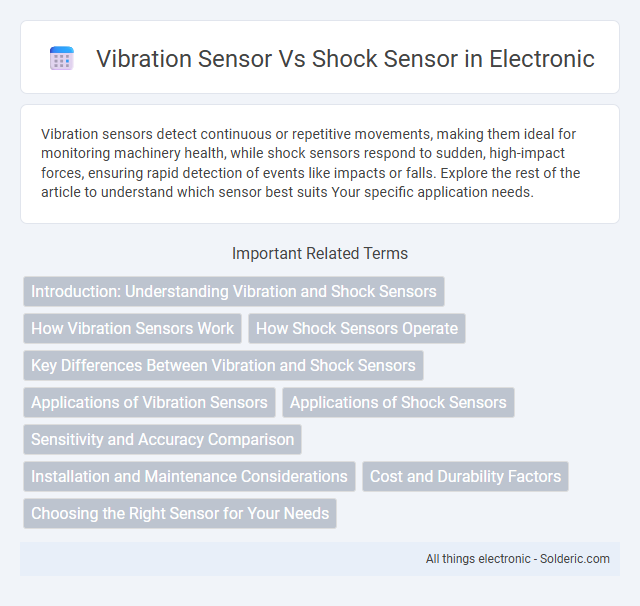Vibration sensors detect continuous or repetitive movements, making them ideal for monitoring machinery health, while shock sensors respond to sudden, high-impact forces, ensuring rapid detection of events like impacts or falls. Explore the rest of the article to understand which sensor best suits Your specific application needs.
Comparison Table
| Feature | Vibration Sensor | Shock Sensor |
|---|---|---|
| Primary Function | Detects continuous vibrations or oscillations | Detects sudden impact or shock events |
| Sensitivity | High sensitivity to frequency and amplitude of vibrations | High sensitivity to instantaneous force or acceleration spikes |
| Common Applications | Machine condition monitoring, structural health, industrial equipment | Impact detection, drop sensors, security alarms |
| Output Signal | Continuous oscillatory signal or analog voltage | Discrete pulse or digital trigger signal |
| Measurement Range | Low to moderate acceleration (Hz range vibrations) | High acceleration over short time (shock spikes) |
| Technology Types | Piezoelectric, MEMS, accelerometers | Piezoelectric, MEMS impact sensors |
| Installation | Mounted on vibrating surfaces or structures | Attached to objects to detect impacts or drops |
| Cost | Moderate, varies by type and sensitivity | Generally lower cost for basic models |
Introduction: Understanding Vibration and Shock Sensors
Vibration sensors detect oscillations or repetitive motions in machinery and structures to monitor performance and predict potential failures. Shock sensors measure sudden acceleration changes caused by impacts or abrupt forces, providing critical data for damage detection and safety monitoring. Both sensors play essential roles in industrial maintenance, automotive safety, and structural health by capturing different types of mechanical disturbances.
How Vibration Sensors Work
Vibration sensors detect oscillatory motion by measuring the velocity, acceleration, or displacement of a vibrating object using piezoelectric, capacitive, or piezoresistive elements. These sensors convert mechanical vibrations into electrical signals that can be analyzed to monitor machine health or structural integrity. Shock sensors, in contrast, detect sudden impacts or high-intensity, short-duration forces rather than continuous or repetitive vibration patterns.
How Shock Sensors Operate
Shock sensors detect sudden, high-impact forces by measuring rapid changes in acceleration or force through piezoelectric or capacitive elements. These sensors convert mechanical shocks into electrical signals, enabling real-time detection of impacts or collisions. Their operation is crucial in applications requiring immediate response to physical shocks, such as in automotive safety systems and industrial equipment monitoring.
Key Differences Between Vibration and Shock Sensors
Vibration sensors continuously detect and measure oscillatory motion or repeated mechanical vibrations, while shock sensors respond to sudden, high-impact forces or abrupt changes in acceleration. Vibration sensors typically provide detailed frequency and amplitude data for monitoring machinery health, whereas shock sensors primarily trigger alerts upon detecting a specific threshold of impact or force. Understanding these differences helps you select the appropriate sensor type for monitoring equipment condition or protecting sensitive devices.
Applications of Vibration Sensors
Vibration sensors are widely used in industrial machinery monitoring to detect imbalances, misalignment, and bearing failures, ensuring predictive maintenance and minimizing downtime. They play a crucial role in structural health monitoring for buildings, bridges, and other infrastructure by identifying potential damage from excessive vibrations. Additionally, vibration sensors are integral in automotive systems for monitoring engine performance and in consumer electronics to enhance user experience through motion detection.
Applications of Shock Sensors
Shock sensors are widely used in automotive airbag deployment systems to detect sudden impacts and ensure timely activation, enhancing passenger safety. These sensors also play a critical role in industrial machinery monitoring by identifying abrupt mechanical shocks that could indicate equipment failure, preventing costly downtime. Your asset protection and safety protocols benefit significantly from integrating shock sensors in electronics packaging, transportation, and structural health monitoring.
Sensitivity and Accuracy Comparison
Vibration sensors typically exhibit higher sensitivity to continuous oscillations and subtle mechanical movements, making them ideal for monitoring equipment health and detecting early-stage faults. Shock sensors are designed to respond accurately to sudden, high-impact events with rapid response times but may have lower sensitivity to low-amplitude vibrations. In terms of accuracy, vibration sensors provide precise measurements of frequency and amplitude over time, whereas shock sensors offer reliable detection of transient shock forces, ensuring effective differentiation between vibration and impact events.
Installation and Maintenance Considerations
Vibration sensors require precise mounting on machinery to ensure accurate detection of oscillatory movement, often necessitating specialized brackets or adhesives for stable installation. Shock sensors, being more sensitive to transient impacts, are typically mounted on rigid surfaces with minimal damping to reliably capture sudden force events. Regular calibration and environmental checks are crucial for both sensor types to maintain measurement accuracy and extend sensor lifespan in industrial applications.
Cost and Durability Factors
Vibration sensors generally have a lower initial cost compared to shock sensors due to simpler design and fewer sensitive components. Shock sensors are typically more durable, designed to withstand sudden impacts and harsh environmental conditions, making them suitable for industrial and automotive applications. The choice between the two depends on budget constraints and the required durability for specific operational environments.
Choosing the Right Sensor for Your Needs
Selecting the appropriate sensor depends on the specific application requirements; vibration sensors are optimal for continuous monitoring of mechanical equipment to detect abnormal oscillations, while shock sensors excel in identifying sudden impacts or accelerations. Vibration sensors typically employ piezoelectric or MEMS technology for precise frequency analysis, whereas shock sensors often utilize accelerometers for rapid event detection. Understanding the operational environment and the nature of the motion is crucial for choosing between vibration and shock sensors to ensure accurate data and effective monitoring.
vibration sensor vs shock sensor Infographic

 solderic.com
solderic.com